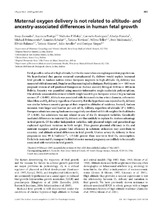Maternal oxygen delivery is not related to altitude- and ancestry-associated differences in human fetal growth

View/
Date
2007-09-16Author
Zamudio, Stacy
Postigo, Lucrecia
Illsley, Nicholas P
Rodríguez, Carmelo
Heredia, Gladys
Brimacombe, Michael
Echalar, Lourdes
Torricos, Tatiana
Téllez, Wilma
Maldonado, Iván
Balanza Erquicia, Elfride
Álvarez, Tatiana
Ameller, Julio
Vargas, Enrique
Metadata
Show full item recordAbstract
Fetal growth is reduced at high altitude, but the decrease is less among long-resident populations.
We hypothesized that greater maternal uteroplacental O2 delivery would explain increased
fetal growth in Andean natives versus European migrants to high altitude. O2 delivery was
measured with ultrasound, Doppler and haematological techniques. Participants (n = 180) were
pregnant women of self-professed European or Andean ancestry living at 3600 m or 400 m in
Bolivia. Ancestry was quantified using ancestry-informative single nucleotide polymorphims.
The altitude-associated decrement in birth weight was 418 g in European versus 236 g in Andean
women (P < 0.005). Altitude was associated with decreased uterine artery diameter, volumetric
blood flow and O2 delivery regardless of ancestry. But the hypothesis was rejected as O2 delivery
was similar between ancestry groups at their respective altitudes of residence. Instead, Andean
neonates were larger and heavier per unit of O2 delivery, regardless of altitude (P < 0.001).
European admixture among Andeans was negatively correlated with birth weight at both altitudes
(P < 0.01), but admixture was not related to any of the O2 transport variables. Genetically
mediated differences in maternal O2 delivery are thus unlikely to explain the Andean advantage
in fetal growth. Of the other independent variables, only placental weight and gestational age
explained significant variation in birth weight. Thus greater placental efficiency in O2 and
nutrient transport, and/or greater fetal efficiency in substrate utilization may contribute to
ancestry- and altitude-related differences in fetal growth. Uterine artery O2 delivery in these
pregnancies was 99 ± 3 ml min−1, ∼5-fold greater than near-term fetal O2 consumption.
Deficits in maternal O2 transport in third trimester normal pregnancy are unlikely to be causally
associated with variation in fetal growth.
